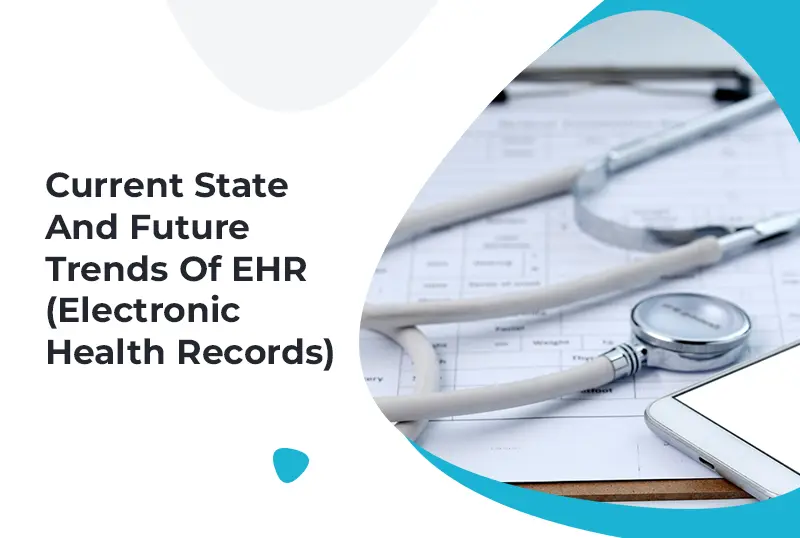Can you recall the time when you had to juggle between tons of paper documents to find a single record? Say goodbye to it as Electronic Health Records (EHR) has now simplified the handling of patient data, enhanced clinical workflow and have positively influenced outcomes for patients. The best part – EHR has not only simplified record keeping but the implementation of AI driven insights help doctors speed up their decisions, seamless data sharing between providers and high security for keeping all the patient’s info in a safe place.
Let’s get into the current state and future trends of EHR (Electronic Health Records)
Current State of EHR
1. Widespread Adoption
Numerous hospitals, specialty clinics and private practices have started using EHR systems. Over 86% of office based physicians and 96% of non-federal acute care hospitals use an EHR system in the United States, according to the office of the National Coordinator for health IT. Government incentives, regulatory compliance and efficiencies in healthcare operational performance have been the driving factors for widespread adoption that leads to changing the current state and future trends of EHR.
2. Enhanced Interoperability
What does interoperability in EHR mean? Interoperability is like ensuring all doctors, hospitals, labs and billing systems are speaking the same language. It reduces awkward misunderstandings. FHIR (Fast Healthcare Interoperability Resources) is a standardized framework that was developed by HL7 (Health Level Seven International) and is meant to facilitate the seamless exchange of healthcare data.
With FHIR being the ultimate translator, patient data now flows effortlessly between different systems, ensuring that medical records do not get lost in translation. This leads to faster treatments, fewer mix-ups and healthier patients.
3. Improved Security and Compliance
The healthcare industry is highly alert about data security as records of patients are gold for cybercriminals. Here, HIPAA(Health Insurance Portability and Accountability Act) regulations come into action to keep the private records of a patient intact. Staying aligned with updated trends and technologies that include advanced encryption, multi-factor authentication, and blockchain, ensuring Fort Knox-level security. This is one of the major changes in the current state and future trends of EHR.
4. Revenue Cycle Management:
Billing headaches? Forget it! Modern EHRs now come with modules for billing and coding that make revenue management in healthcare less of a headache, fewer denials of claims, and more reimbursement. With AI-driven automation, cash flow is smooth, compliance becomes stronger, and administrative stress melts away, so healthcare professionals can focus on doing what they do best: take care of patients.
Future Trends of EHR
1. Integration of AI and Machine Learning
EHR functionalities are transformed nowadays by artificial intelligence (AI) and machine learning (ML). AI-based systems can do the following:
- Predict the risk of patients based on past data.
- Automate administrative tasks, like appointment scheduling and documentation.
- With evidence-based recommendations you can easily enhance clinical decision support systems.
- Medical coding helps in improving the accuracy of medical billing operations resulting in more revenue and offering best patient care.
2. Cloud-Based EHR Solutions
Scalability, affordability, and easy accessibility – what’s not to love? Cloud-based EHRs are being increasingly adopted today, attributing to low upfront costs and effortless accessibility. At a time when remote healthcare services are booming, cloud platforms make it possible to access patient data anytime and from anywhere. Whether, it is the telehealth provider peeking into patients or a multi-branch healthcare network keeping everything in line, cloud EHRs are definitely making life easier for everyone!
3. Blockchain for Data Security
Blockchain technology is going to be a game-changer for EHR security. It uses decentralized and tamper-proof data storage, which ensures:
- Higher sensitivity and privacy concerning the patient’s information.
- Reducing online fraud and hackers attacks.
- Ensure increased data reliability and transparency especially with the Electronic medical records
4. The patient-centered Electronic Health Record system.
The next wave of EHR is all about making patients the master of their universe. Future versions will be a lot more intuitive; they will enable more active roles that patients can have in their lives. From easy-access patient portals and real-time insights into health, these digital records continue to evolve as a means by which individuals remain on top of their wellness like never before.
5. Voice Recognition or NLP-based
The integration of voice recognition and NLP technologies in EHR systems may allow physicians to dictate notes where the same is automatically transcribed and structured, thereby reducing the time spent on data entry as it allows them to spend more time with patients.
6. IoT and Wearable Device Integration
It will further allow patients to be better and more advanced real-time monitored because EHRs can integrate information received through smartwatches, fitness trackers and other medical wearables, thus keeping the care provider constantly updated about a patient’s health condition to allow for timely interventions.
7. Integration of Personalized Medicine and Genomics
The study of a person’s genes to understand their health and risks is known as Genomics. Genomics and personalized medicine once integrated with EHRs, doctors are then able to predict diseases and select the best treatment based on genetic information.
8. Regulatory Changes and Compliance Updates
The future of EHR is directed by a shifting landscape of regulation. Better laws, including the 21st Century Cures Act, force increasing availability of data and better interoperability for health care providers, insurers and medical billing services to access patient records.
Challenges and Considerations
Even with such a bright future for EHRs, there are some challenges that healthcare organizations need to face:
- Data Security Concerns: With increasing cyber threats, investing in robust cybersecurity measures is essential.
- Interoperability Hurdles: Despite progress, seamless data exchange between different systems remains a challenge.
- Physician Burnout: EHR usability must be optimized to reduce administrative workload and improve user experience.
- Implementation Costs: Transitioning to advanced EHR systems requires significant investment in technology and training.
Conclusion
EHRs are at the current stage of widespread adoption, improved interoperability, and top-tier security. The future, however, is brighter than ever! AI, blockchain, IoT, and cloud-based solutions will lead the charge in EHRs, which will continue to evolve the healthcare industry.
Sustainability of the curve ahead requires healthcare providers to be ahead, embracing technology and optimizing workflows so that they can unlock the full potential of EHR: higher-quality care, operations flow effortlessly and revenue cycles improve.
EHR Future is innovative, well-arranged, and pretty exciting.







